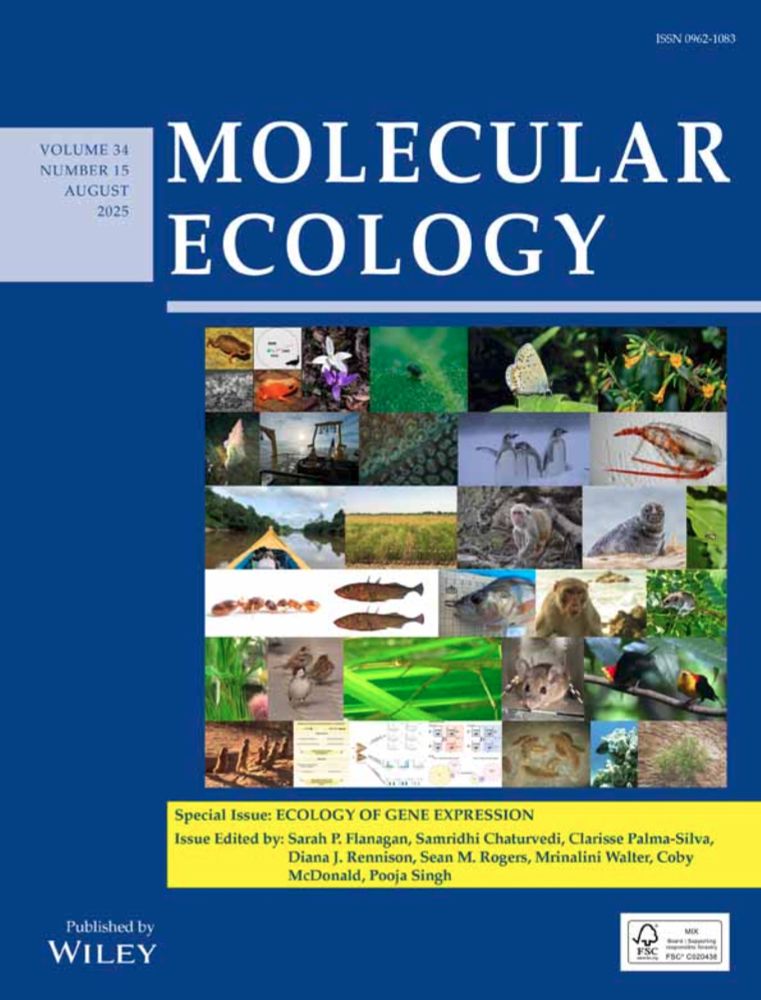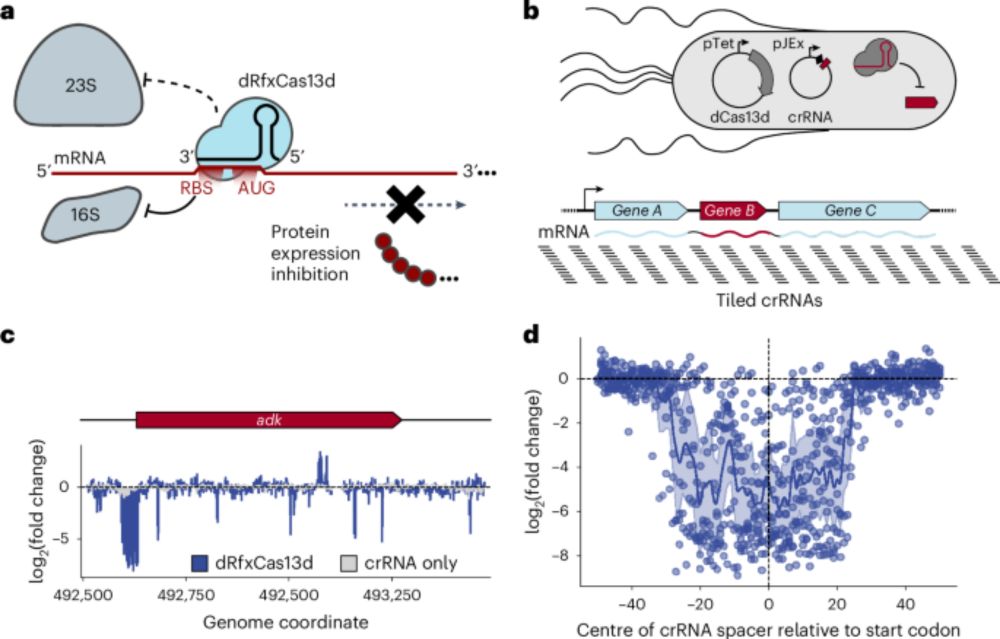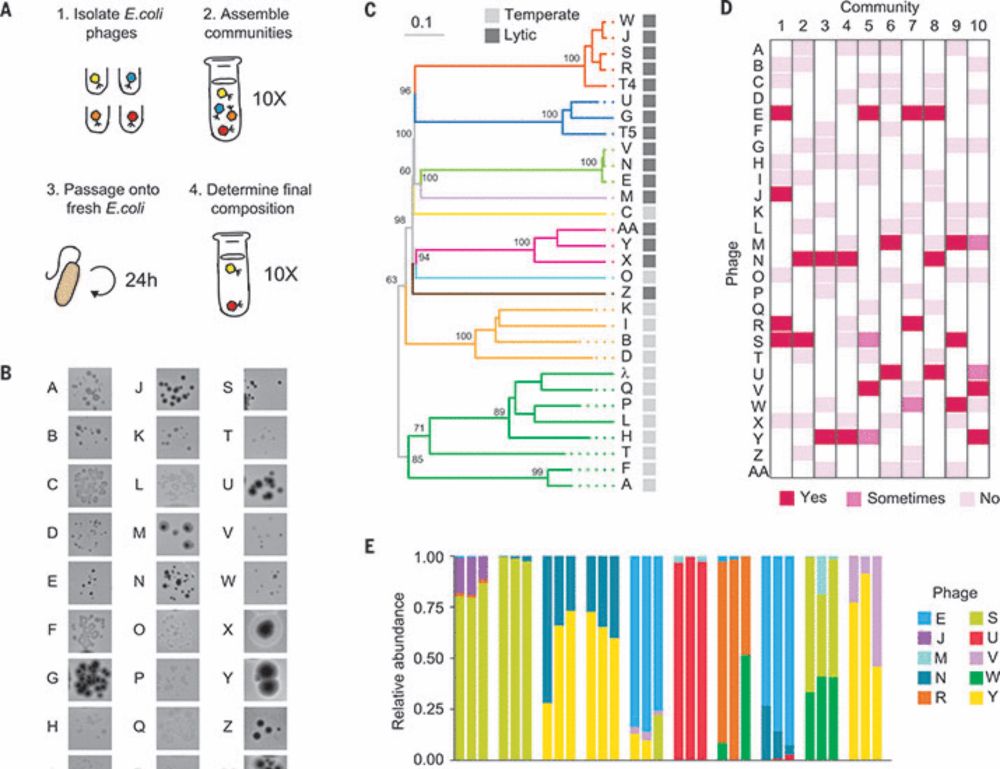
A call for caution in the biological interpretation of viral auxiliary metabolic genes - Nature Microbiology
This Perspective discusses virus-encoded auxiliary metabolic genes and provides a framework for the biological interpretation of these genes.
New paper alert! We suggest caution in the analyses of viral auxiliary metabolic genes and propose a new overarching term - 'auxiliary viral genes' (AVGs) to describe different types of such genes. @simrouxvirus.bsky.social #phagesky #Microsky www.nature.com/articles/s41...
27.08.2025 12:24 — 👍 74 🔁 37 💬 2 📌 2
#phage #phagesky a great review on Viromics by @simrouxvirus.bsky.social
23.07.2025 04:48 — 👍 7 🔁 2 💬 0 📌 0

The picture shows a conference room with a speaker on a podium on the left, a large screen with a scientific diagram in the middle and the audience on the right.
Kicking off Sunday morning #ASMicrobe with an entire phage ecology session \o/ thanks to @cathyhernandez.bsky.social and @phagebeelicious.bsky.social . And first, @cynthiasilveira.bsky.social on phages and geochemistry 🤩
22.06.2025 15:22 — 👍 31 🔁 1 💬 3 📌 0

Sunday Sketch: Bumble Bee
Some bumble bee species are able to inhabit extremely cold environments, with their distribution stretching far north into the Arctic Circle. Vector art and fact by Danielle Rutkowski, Bluesky @dan…
Here’s an out-of-this-world-themed bumble bee! 🐝 Vector art and a fun fact about bees by @daniellerutkowski.bsky.social , screen-printed as a sticker by @phagebeelicious.bsky.social.
#SciComm #BeeArt #VectorArt #ScreenPrinting #Pollinators #SciArt #Bumblebee #InsectArt
20.06.2025 04:55 — 👍 2 🔁 1 💬 0 📌 0
Excited to be on the way to #ASMicrobe once more ! And if you want to know more about our work on CRISPRs, metagenomes, and phages, please come and chat and/or come see me tomorrow morning (9:15am in the EEB-IDS-202 session, which looks amazing overall !)
19.06.2025 18:38 — 👍 30 🔁 5 💬 2 📌 0
Day: June 22, 2025
Time: 8:15-10:15AM
Location: 403A
Session page (with speaker schedule): www.abstractsonline.com/pp8/#!/20974...
16.06.2025 18:25 — 👍 0 🔁 0 💬 0 📌 0
Going to ASM Microbe 2025?
Check out the in-depth symposium "Phage Ecology: From Prophage Decision Making to Ecosystem Modulation" hosted by Dr. Hernandez (@cathyhernandez.bsky.social) and I!
We have some really cool talks lined up.
Hope to see you there!
🧪🦠🔬
#Phagesky
#Microsky
16.06.2025 18:23 — 👍 13 🔁 10 💬 1 📌 0
Get ready to dance, our paper – Phage DisCo: targeted discovery of bacteriophages by co-culture – has been pre-printed! 🪩 This has been a really fun project to work on with @sianowen.bsky.social, @baym.lol, @nquinoneso.bsky.social, and our two talented undergrads Kesther and Carmen!
23.11.2024 18:12 — 👍 205 🔁 78 💬 4 📌 9
This is great! Can you please add me too?
23.11.2024 17:15 — 👍 0 🔁 0 💬 1 📌 0
Program Planner
Session details: www.abstractsonline.com/pp8/#!/20974...
Abstract submission guidelines: asm.org/Events/ASM-M...
Key Dates: Early Submission Deadline: Dec 3, 2024 at 12 p.m. ET.
Regular Submission Deadline: Jan 22, 2025 at 12 p.m. ET.
23.11.2024 05:25 — 👍 0 🔁 0 💬 0 📌 0

Working on phage research?
Dr. Catherine Hernandez and I are co-convening the "Phage Ecology: From Prophage Decision Making to Ecosystem Modulation" in-depth symposium at ASM Microbe 2025 and we want YOU to be part of it!
Abstract submission is now open!
More info below
🧪🦠🔬
#Phagesky
#Microsky
22.11.2024 23:07 — 👍 45 🔁 27 💬 2 📌 2
Interesting! This was lysate from a webbed plate. So maybe it’s a bacterial vesicle
22.11.2024 03:44 — 👍 1 🔁 0 💬 0 📌 0

A cryo-EM image of two tailed phage and a third circular object. Phage heads are ~50nm in diameter. Phage tails are ~150nm long.
Finally got around to processing my first cryo-EM image! This tailed phage was isolated from the gut of a honey bee and targets Bifidobacterium. Not 100% sure what the other circular structure is. If you have any ideas, let me know! 🐝🦠🧪 #phagesky
21.11.2024 18:47 — 👍 54 🔁 5 💬 5 📌 1
Thank you Titus =)!
23.08.2024 21:08 — 👍 1 🔁 0 💬 0 📌 0

This is a cryo-EM image taken of a bacteriophage (phage) isolated from the gut of a bee. In the image, you can see two phage particles of similar size. Both phage particles have heads, portals, and are tailed. The phage are approximately 200nm long (from head to tail)
cryo-EM image of phage isolated from bee gut material! More images (and experiments!) coming soon 🐝🦠🧪
29.07.2024 16:01 — 👍 2 🔁 0 💬 0 📌 0

Phage on a plate! 🐝🦠🧪
18.07.2024 05:57 — 👍 0 🔁 0 💬 0 📌 0

Targeted Viromes and Total Metagenomes Capture Distinct Components of Bee Gut Phage Communities
bioRxiv - the preprint server for biology, operated by Cold Spring Harbor Laboratory, a research and educational institution
Hey science friends! Ever wonder what the phage community of bumble bees look like? Or how to best sample host-associated phage communities? Check out our new preprint!
Turns out that the bumble bees we sampled hosted extraordinarily low diversity phage communities, relative to honey bees. 🐝🦠🧪
15.02.2024 21:31 — 👍 11 🔁 5 💬 0 📌 0
This is the BlueSky home of the Microbiology Graduate Group at the University of California, Davis 🦠🧫👩🔬🧑🔬🧬🔬
Phage Group @ Laboratoire de Chimie Bactérienne
#phage genomics, #phage-host interactions, #phage-host coevolution
PostDoc in The Maxwell Lab at the University of Toronto. PhD. CIHR and EPIC-GSK Postdoctoral Fellow. | He/Him 🏳️🌈 Co-Founder of Pride in Microbiology | Saamis(Prairies) ➡️ Kjipuktuk(Halifax) ➡️ Tkaronto(Toronto).
Postdoc at Newton Lab (@IUBiology). Eco-evolution of symbiosis. Microbiomes | Bees | Virus, Bact, Fungi. 🇧🇷 in 🇺🇲. https://liliancaesar.com/
Group Leader @ Quadram Institute. Phages, viromes and taxonomy with a side of gaming and yarn arts. EDI & Athena Swan lead. Ally.
Researching the diversity and interaction of phages with plant pathogenic bacteria 🌱🔬 | INRAE | PHIM | Montpellier, France. 🇵🇸
Viral ecologist with Evelien Adriaenssens at The Quadram | All things phage (but mostly viromes) | Formerly at Uni of Nottingham with Andy Millard | All opinions my own.
Microbial ecologist and phage enthusiast, Assistant Professor at the University of Miami: www.silveiralab.com
Studying bee microbiome and phage
| 🐝🦠 | Evolutionary biology, symbiosis, phylogenetics
Bioinformatics PhD student - U Idaho
👩🏻🏫4th Year Entomology PhD Candidate at UC Davis
🐝Studying Bee-Microbe Interactions
Postdoc @ Doudna Lab - UC-Berkeley | Bacteriophage engineering | CRISPR | Biotechnology | Microbiology | All Combinations Thereof | He/him. Opinions my own.
The Cress Lab | Innovative Genomics Institute @ UC Berkeley | Microbiome Editing | Microbiome Delivery Technologies | Phage and MGE Functional Genomics | Hiring!
https://www.cresslab.bio/
The official "Resistance" team of U.S. National Park Service. Our website: www.ourparks.org
Facts & strategy, in an authoritarian takeover.
Rightwing billionaires want to privatize NIH and use it to control universities.
We work to cure diseases like cancer.
Pers views. #science #medicine
UC Irvine, UCI Microbiome, Orange County Phage Team, Fiber Evangelist https://kwhiteson.bio.uci.edu/
Associate Professor at UW-Madison. Interested in Microbial and Viral Ecology, Computational Biology, Biogeochemistry, Sulfur Metabolism🦠💻 Hero to a toddler • Metalhead • Views mine
Senior Editor at Nature Microbiology 💻📄 | handling mycology, parasitology, AMR and phage therapy | https://www.nature.com/nmicrobiol/
Virologist, Chief Editor of Frontiers in Virology.
Emeritus & Visiting Professor of Tokushima University, Japan.
Foodie. Cat lover. Big fan of Japanese temples, shrines and castles.
https://www.frontiersin.org/journals/virology














